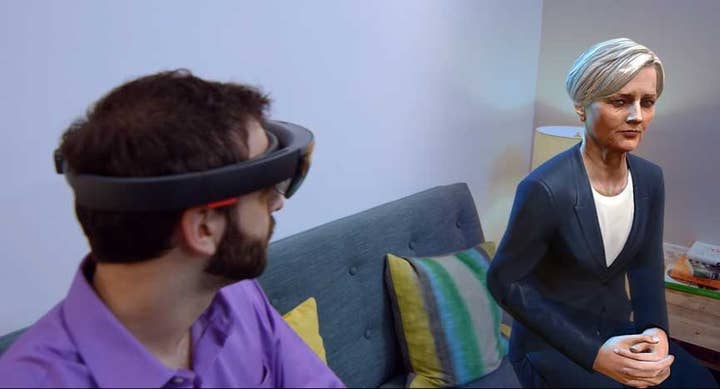Asobo Studio: Lessons from the frontline of HoloLens development
"Sometimes experience is a trap. As an experienced developer you might think, 'In this case, let's do that.' But you're wrong"
For game developers today, the limitless flow of new product is at once exhilarating and terrifying. More and more people are playing more and more games, and the platforms through which they can be sold are now groaning beneath the weight. In that environment, a patch of blue ocean is a rare thing. The chance to be the first to take the plunge is rarer still.
Asobo Studio earned that chance through hard-work and experience. The French studio had developed a series of games based on Pixar movies for THQ and Disney, which led to the opportunity to make Kinect Rush for Microsoft. The fate of the Kinect is now a matter of public record, but Asobo's knack for adapting to new technology did not go unnoticed. When Microsoft started looking for developers to work with HoloLens, the French developer was among the first to get the call.
"People compare VR to AR most of the time, maybe because the devices look a bit the same. Really, they aren't at all"
But if experience was how Asobo became the first independent developer to work with HoloLens, the value of that experience was undermined by the radical nature of the technology. "Sometimes experience is a trap," says David Dedeine, Asobo's co-founder and chief creative officer. "As an experienced developer you might think, 'In this case, let's do that.' But you're wrong."
HoloLens emerged just as the hype around VR was reaching a crescendo, leading many to regard the technologies as somehow connected. In many discussions, the terms "AR" and "VR" are almost interchangeable, as if they are iterations of the same basic idea. Though Dedeine believes that, eventually, a single device will be able to provide both experiences, there are few similarities that will prove useful to a VR developer interested in creating content for HoloLens. Asobo has worked with both VR and AR, he says, and from a design standpoint AR is, "more interesting and more challenging at the same time."
"VR is really a more classic video game thing, but super immersive," he says. "At the end of the day it stays a virtual world, whereas AR is really different. The real world needs to be central to the experience, and because of that I think they are actually very different. People compare VR to AR most of the time, maybe because the devices look a bit the same. Really, they aren't at all."

Asobo's early prototypes included a hologrammatic chess game akin to that played by Chewbacca and R2D2 in Star Wars - just type "Let the Wookie win" into Google and you'll find it in no time - but this was a classic example of experience becoming a trap. It was a familiar idea, and simple to execute. "Lots of people will do that," says Dedeine. "It was too easy."
The more Asobo understood about AR, the more it highlighted the degree to which VR could still use the tropes and techniques of traditional games. The fact that VR developers are creating entire virtual environments means that, with the right execution, disbelief can be suspended in any direction. A console player and a VR player can both inhabit the character of Nathan Drake, for example, or any other character for that matter. "You can be anyone and you can be anywhere," says Dedeine. "In an AR game, the starting point is the user. You cannot force the user to pretend to be a star commander.
"The starting point is the user's own life... It's something you never do; never in a book, never in a movie. It never happens"
"You build the experience towards something great, but the starting point is the user's own life. In terms of narrative, AR is completely different. You need to rethink. It's something you never do; never in a book, never in a movie. It never happens."
For the most part, any perceivable weakness in AR organically leads to a perceivable strength. Granted, an AR gamer may never believe they are Master Chief, but a VR gamer asked to immerse themselves in that particular illusion will likely do so while sitting down, with the ever present risk of feeling sick. According to Dedeine, once an AR experience is running at a high enough frame-rate, motion sickness is "off the table" altogether. In addition, with HoloLens there is "no actual limitation" on the player's movement around their environment, which bypasses the inner-ear confusion that will always be an issue for developers working with entirely simulated worlds.
However, the task for an AR developer is to make the real world an interesting place with which to interact. While HoloLens is more portable than, say, HTC Vive, the technology hasn't advanced to the point where it's likely to be used in a broad variety of real-world locations. When Asobo develops an idea for AR, Dedeine says, the assumption is that the user will generally be situated in a limited number of domestic environments - the lounge, the kitchen, the bedroom, and so on. The most obvious challenge, then, is to make a tan couch and some Ikea furniture the backdrop for a compelling interactive experience.
"We cannot predict where they will play, or you will play, or I will play, and all of those rooms will be completely different," says Dedeine. "You can never bet on what will be the actual environment of the user, which means that, whatever the design, you need to make sure that works in any any environment."

Despite their significant differences, both Young Conker, a third-person platformer, and Fragments, a first-person detective game, are made possible by a tech solution that Asobo calls, "The Solver." Dedeine is reluctant to disclose the details of exactly how it works, but when either experience begins The Solver interprets the "cloud of data" that HoloLens draws from the user's environment to map various objects and systems onto the room in an intelligent manner. It goes beyond simply registering the contours and angles of furniture; to use Dedeine's example, if The Solver needed to place a wine bottle as a clue in Fragments, it would be able to place it on a surface where that object might reasonably appear - on a table rather than a couch, for example. This kind of accuracy is essential, Dedeine says, and The Solver is, "super accurate."
"This is the most exotic experience I've had as a developer. The paradigm is so different that we have to be like students"
AR developers will face these and other issues, but the most widely publicised challenge is, according to Dedeine, the least important. HoloLens' limited field-of-view (FOV) has attracted criticism ever since the device made its debut, and Dedeine admits that he'll be the first to celebrate when the technology evolves towards a larger window on the hologrammatic world. However, he insists that the combination of smart design and the way the human eye functions diminish its importance in a relatively short space of time.
"In your real life, you look where you need to, but you are focused on a point," he says. "As soon as you have an experienced user this issue almost disappears. Obviously, it would be better - I don't want to be blind to the issue - but it's not a limitation that breaks the experience... [A bigger FOV] will be a huge improvement when it happens, but it's a bit like complaining about the size of the very first iPhone."
With both VR and AR, the notion that the best is yet to come is ever present. When Dedeine reflects on Asobo's journey to gain even this level of understanding he compares it to, "climbing a mountain" - from the intimidating feeling of rambling among the foothills in those early encounters with HoloLens, to the mixture of elation and apprehension at conquering one peak only to notice an even larger one looming up ahead.
"It's been a real adventure," he says. "But it was hard, and if you'd interviewed me at other moments I'd have told you, 'I hate the world.' This is the most exotic experience I've had as a developer. The paradigm is so different that we have to be like students again.
"You have to give your best, you have to be smart, and you have to be humble."









